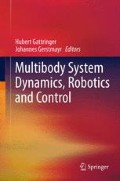Abstract
Control schemes for wheeled mobile robots typically assume a specific mobility capability of a drive and implicitly use the drive’s kinematics within its control procedures. This makes it difficult to deal with faults in the drive and to handle drives with diverse geometry and functionality that might even change during operation of a robot. As a consequence, we propose a model-based control scheme that builds upon an automated analysis of a robotic drive and on an on-line deduction of the drive’s kinematics. We achieve this functionality through (1) the introduction of steering-angle independent, generalized variants of the rolling and sliding constraints for wheeled mobile robots and (2) the corresponding reformulation of kinematic analysis. This leads to a computationally efficient algorithm that deduces the (inverse) kinematics of a drive for its mode of operation or failure. Fault tolerant and robust behavior, however, is only one aspect of our control architecture. On-line kinematics analysis enables us to easily handle robots that change in geometry or functionality such as self-configuring modular robot systems and teams of cooperative robots.
Access this chapter
Tax calculation will be finalised at checkout
Purchases are for personal use only
Notes
- 1.
It is straight forward to include mecanum wheels as well. The associated details are given in the Appendix.
- 2.
Of course, this only holds for steered wheels with unconstrained steering angles.
- 3.
More detailed analysis shows, that these are those motion set-points, which place the ICR in the wheel contact point.
References
Alexander J, Maddocks J (1989) On the kinematics of wheeled mobile robots. Int J Robot Res 8:15–27
Bhatt R, Tang C, Krovi V (2009) Formation optimization for a fleet of wheeled mobile robots – a geometric approach. Robot Auton Syst 57:102–120
Campion G, Bastin G, D’Andréa-Novel B (1996) Structural properties and classification of kinematic and dynamic models of wheeled mobile robots. IEEE Trans Robot Autom 12:47–62
Robuffo-Giordano P, Fuchs M, Albu-Schäffer A, Hirzinger G (2009) On the kinematic modeling and control of a mobile platform equipped with steering wheels and movable legs. In: Proceedings of the IEEE international conference on robotics and automation (ICRA09), pp 4080–4087
Hofbaur M, Brandstötter M, Schörghuber C, Steinbauer G (2010) On-line kinematics reasoning for reconfigurable robot drives. In: Proceedings of the IEEE international conference on robotics and automation (ICRA10), pp 5441–5446
Hofbaur M, Brandstötter M, Jantscher S, Schörghuber C (2010) Modular reconfigurable robot drives. In: Proceedings of the international conference on robotics and automation and mechatronics (RAM 2010), pp 150–155
Kim W, Lee S, Yi B (2002) Mobility analysis of planar mobile robots. In: Proceedings of the IEEE international conference on robotics and automation (ICRA02), pp 2861–2867
Nüchter E, Bahr E, Lohmüller H (2008) Omnidirektionales Fahrzeug, Fahrmodul und mobiler Industrieroboter. German Patent Office, Offenlegungsschrift DE 10 2007 016 662 A1
Rienmüller T, Gruber C, Brandstötter M, Hofbaur M (2011) Odometry-based fault diagnosis for pseudo-omnidirectional wheeled mobile robots. In: Proceedings of the 22nd internationalworkshop on principles of diagnosis (DX11), Murnau, Germany, pp 29–35
Siegwart R, Nourbakhsh I (2004) Introduction to autonomous mobile robots. MIT Press, Cambridge
Williams B, Ingham M, Chung S, Elliott P, Hofbaur M, Sullivan G (2003) Model-based programming of fault-aware systems. AI Mag 24(4):61–75
Zassenhaus H (1948) Über einen Algorithmus zur Bestimmung der Raumgruppen. Commentarii Mathematici Helvetici 21:117–141
Acknowledgement
This work has been funded through the Austrian Science Fund (FWF) under grant no. P20041-N15.
Author information
Authors and Affiliations
Corresponding author
Editor information
Editors and Affiliations
Appendix
Appendix
11.1.1 Qualitative Rolling and Sliding Constraints for an Omni-Directional Mecanum Wheel
It is straight forward to provide qualitative sliding constraints for Mecanum wheels as well. If one considers a mecanum wheel with the geometry as shown in Fig. 11.6, one obtains the standard rolling and sliding constraints as
Note that a fully operational mecanum wheel (actuated or freely spinning) does not impose any constraints on the robot’s movement as the rotation of the individual rolls ensures the sliding constraint 1.32. We express this fact in terms of a qualitative constraint with \( {\mathbf{c}}_q^T: = \left[ {\begin{array}{clclcllc}{0\:} & {0\:} & 0 \\\end{array} } \right] \). The rolling constraint is time-invariant as mecanum wheels are typically used without active steering. Therefore, we obtain \( {\mathbf{j}}_q^T: = \left[ {\begin{array}{clclcllc}{\rm sin(\alpha + \beta + \gamma )\:} & { - \rm cos(\alpha + \beta + \gamma )\:} & { - l\rm cos(\beta + \gamma )} \\\end{array} } \right] \). However, a blocked mecanum wheel exhibits a behavior, where the individual rolls act like non-actuated standard wheels at \( \beta + \gamma + \tfrac{\pi }{2} \). The according qualitative sliding constraint is thus
We summarize the matrix entries \( {\mathbf{c}}_q^T \) and \( {\mathbf{j}}_q^T \) for the qualitative constraint matrices \( {{{\mathbf{C}}}_q} \) and J q in Table 11.2.
Rights and permissions
Copyright information
© 2013 Springer-Verlag Wien
About this paper
Cite this paper
Hofbaur, M., Gruber, C., Brandstötter, M. (2013). Automated Kinematics Reasoning for Wheeled Mobile Robots. In: Gattringer, H., Gerstmayr, J. (eds) Multibody System Dynamics, Robotics and Control. Springer, Vienna. https://doi.org/10.1007/978-3-7091-1289-2_11
Download citation
DOI: https://doi.org/10.1007/978-3-7091-1289-2_11
Published:
Publisher Name: Springer, Vienna
Print ISBN: 978-3-7091-1288-5
Online ISBN: 978-3-7091-1289-2
eBook Packages: EngineeringEngineering (R0)


